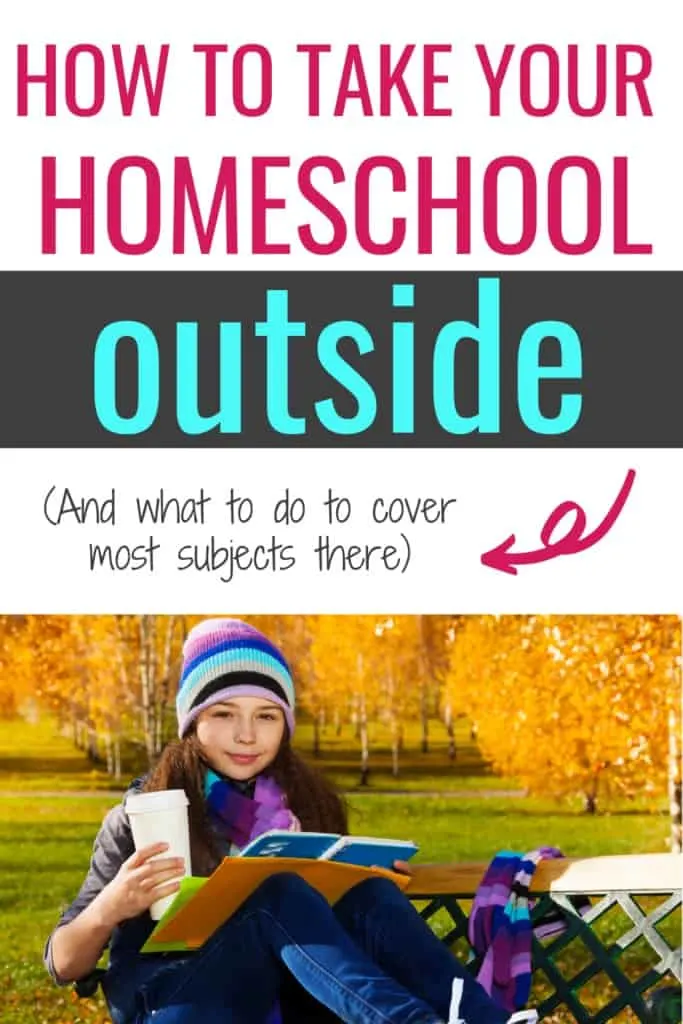Just because you’re a homeschooler doesn’t mean you love being in your house all the time. Sometimes a lack of variety can make your learning experience feel stifled and uninspired. If you’re suffering from a case of the homeschool blahs, why not trying switching things up and doing some outdoor learning activities?
In this guest post, Amy Pak from Homeschool in the Woods offers tons of tips on how to take your homeschool outside and breathe new life into it.

We’ve seen unprecedented times this year, not just as homeschoolers, but globally. “Sheltering-at-home” has definitely thrown us into lock-down mode, with little room to stretch out, which can make a family a bit stir-crazy.
How can we continue to educate our children yet get them active and give them room to work out the wiggles? That’s easy… by taking the schooling outside!
Staying home does not necessarily mean staying indoors the whole time. By using the yard as a place to explore or a haven for fun outdoor learning activities, you will not only get some fresh air, but also discover some really cool things about the natural world.
The Perfect Place for Some Science Activities
With spring upon us, there are ample ways to incorporate the sciences. You can turn the following activities into a DIY unit study, or just try them out individually and see what catches everyone’s interest.
By taking the time to set up a garden, you can take your child(ren) through the stages of plant growth, from seeds to seedlings to establishing a garden, and eventually harvest time.
You can even take this opportunity to share about Victory Gardens of WWII and how they were often shared by the community.
Do you have woods or a pond nearby? Try observing the pond life or capturing tadpoles. Do you have access to a microscope? Gather a variety of plant life and soil to take a look at it up close.

You may also want to incorporate watching the wildlife. What birds live in your area? Make note of their coloring and look them up on the internet.
This might be a great time to create a bird feeder or nesting box with hopes of having “visitors” on a regular basis. There are also options for making bird treats you can hang from branches to lure in the wildlife. One example is to take a large pine cone (the larger, the better) and smear it with lard, suet, shortening, or peanut butter, and roll it in birdseed. Tie the pine cones to the branches of a tree.
Scavenger hunts are always a hit. Give your child a list of items to find and collect in a bag. You can focus on specific objects, too, such as leaves or rocks. Have him create a classification list of the items he finds.
If you don’t mind a little digging in the ground, teach your child about archaeology, and create a “dig site.” By plotting off an area, you can bury several items such as old buttons, pieces of pottery, broken jewelry, or any odd items, and have your child excavate the area.

Have him use a hand shovel and old paintbrush to carefully dig the area and find the “treasures of the past.” Then have him record each finding on paper, classifying what he found, the plot area he found it in, and how deep it was in the ground.
This is also a great time to study meteorology and create your own weather instruments. Look online to find ways to make your own thermometer, barometer, anemometer, or wind vane.
Outdoor Learning Activities for Teaching History
If you are studying about Westward Expansion, you might want to take anything plastic with small sides to it, such as a kiddie pool or a plastic toboggan, and fill it with dirt and water. Toss in a few gold craft beads. Give the child an aluminum pie tin and have them pan for gold.
There are various sources online instructing how to do it the “official way.” When a gold miner found enough gold, he would bury his “cache” in the ground and create a map to remember where he placed it. Your child can do that with the gold beads he finds, or you can create a cache for your child to track down.
Fill a baggie with stickers and small treats and bury it in the yard. Have the child follow the map and landmarks to find it.
Studying the thirteen colonies? You can also utilize the driveway or sidewalk. Have the child draw a map of Colonial America and use it for hopscotch. You can also use the length of a driveway for a child to draw a simplified timeline of people and events you have been studying.

A Little Math, Anyone?
A driveway or sidewalk also makes the perfect canvas for doing some math problems. How about plotting coordinates on a graph to create a picture? There are graphing worksheets online for making this a fun outdoor learning activity.
We discussed mapping for a cache above, but how about mapping the yard in general? Create a map including actual measurements that include the circumference of trees and the length of the driveway or gardens.
Measure the perimeter of any buildings on the property, such as a house or shed, and place it at its appropriate location on the map. Don’t forget to include anything that might be within the yard, such as a mailbox, sidewalks, swing set, or fire hydrant, to name a few. If you want to try this on a larger scale, try mapping the neighborhood.
Loving Literature in the Shade…
Outdoor learning activities don’t always have to be structured or have a particular learning outcome in mind: Who wouldn’t want to plunk down on a blanket with a picnic lunch and a good book? The peaceful outdoors is an ideal atmosphere for enjoying a good story, whether independent reading or read-aloud.

Nature is a great inspiration for poetry, too. You can read classic poems about nature by poets such as Robert Frost, Alfred Lord Tennyson, or William Wordsworth, or have the child write their own. Even younger ones can try their hand at poetry with a little Haiku.
Don’t forget Bible study: This is an opportune time to spend an hour in The Word together.
Of Course, Art is a Given!
By taking the colored pencils or watercolors outside, your child can draw or paint what she sees. There is an abundance of ways to incorporate art into the outdoors.
Charlotte Mason was a turn-of-the-20th-century British educator who believed children should be individually respected, and their education should be broad and rich by teaching the whole child, not just the mind.
One idea from her method was creating a nature journal. By sitting outside and drawing and jotting notes of what the child sees, it causes her to be observant and creative. This can be an ongoing project that is added to all year.
Finally, DRILL!
Children don’t always take too well to remedial drill exercises, but when you turn it into a game, not only will they learn the material, they will have fun doing it.
Try creating a baseball diamond in the yard. As each child answers a question correctly, they will advance to the next base. You can score their “runs” to see who wins. This works well with questions on any topic and is perfect for Bible quizzing, spelling, or math-fact practice.
You can also create a path on the driveway by drawing a row of “hopping” stones. As each child answers the question correctly, he advances to the next stone until he has completed the course.
This also works wonderfully if you have a basketball hoop, by earning attempts to make a basket. Or, have the child stand far enough away to make it difficult for her to make a basket. Each right answer means a step forward with an opportunity to shoot a basket once she feels she can make it. Wrong answers mean a step backward.
You can see that there are many ways to bring the schooling outdoors and get some movement in your day, especially at this time when many of us are stuck at home for the most part.
It also lightens the mood and provides an excellent atmosphere for learning. Next time you have a good-weather day, grab a good book, head outside, and throw down a blanket… Your kids will thank you for it.

Amy Pak is an 18-year homeschool veteran to four and a “Maimy” to seven grandkids. She is also the co-owner, illustrator, and co-author at Home School in the Woods, a family-run history company known for its historical timeline figures and hands-on history studies. You can read more of Amy’s writing on her company’s blog.
